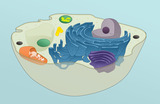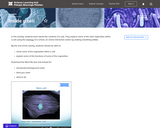
Cell Organelle Jigsaw gallery walk.
- Subject:
- Science
- Material Type:
- Activity/Lab
- Assessment
- Author:
- TERRI MOYER
- Date Added:
- 06/01/2020

Cell Organelle Jigsaw gallery walk.

Students will be immersed into a eukaryotic cell. In this immersion, students will demonstrate how the structures of organelles allow for their specific functions. In addition, students will be able to describe the structure and various functions of proteins.

Students review and compare plant and animal cells, and then build a model of an animal cell.

Students review cell structures and investigate how the components of a cell operate as a system. Throughout the lesson, students will compare a factory to a cell, beginning to understand how both can be thought of as a system.

In this lesson, students will list the major organelles of animal and plant cells and describe their functions. Students will also summarize the hierarchical organization of multicellular organisms from cells to tissues, organs, systems, and organisms.

This is an interactive resource that allows students to practice labeling both plant and animal cells with immediate feedback. Please note you will need to enable flash on your browser to use this game

This interactive resource reviews the major organelles of the eukaryotic cell and examines structure and function.

Within the life science strand of 7th grade science, students focus on the processes, structures, and functions of living organisms that enable them to survive, reproduce, and carry out the basic functions of life. In this task, students research endosymbiotic theory and create fictional narratives from the point of view of the prokaryotic cell, aerobic bacterium, and photosynthetic bacterium involved in the collaboration forming the first eukaryotic cell. The interdisciplinary and creative nature of this activity allows students to build meaningful connections while promoting 21st Century Skills. This lesson was developed by NCDPI as part of the Academically and/or Intellectually Gifted Instructional Resources Project. This lesson plan has been vetted at the state level for standards alignment, AIG focus, and content accuracy.

In this lesson plan from the Utah Education Network, students will research then create a trading card about a specific organelle. A student worksheet is included.

The Lives of Cells Student Edition book is one of ten volumes making up the Human Biology curriculum, an interdisciplinary and inquiry-based approach to the study of life science.

In this activity, students construct a model of a plant or animal cell using edible materials.

Students learn about the contents of a cell. They explore some of the main organelles within a cell using the analogy of a school, an online game and/or by making something edible.

This short video lesson provides a detailed examination of the cell membrane. Assessment and discussion questions, as well as links to additional resources, are included.

This resource is fully aligned to 7.L.1.2 — Compare the structures and functions of plant and animal cells, including major organelles (cell membrane, cell wall, nucleus, chloroplasts, mitochondria, and vacuoles). Students identify the organelles, describe the function and then peer review others. This resource is engaging, and effectively utlizes technology to engage all learners. It does require access to the following materials, makey makeys, alligator clips, playdoh, and foam board.

Students will read a passage and write answers to questions based on the passage. This resource supports English language development for English language learners.

Students will learn about the main components of both animal and plant cells. After examining diagrams of plant and animal cells, students will note similarities and differences between the two on a Venn diagram. Students will then create a 3D cell model.

CK-12 Life Science Honors For Middle School covers seven units: Understanding Living Things; Cells: The Building Blocks of Life; Genetics and Evolution; Prokaryotes, Protists, Fungi, and Plants; The Animal Kingdom; The Human Body; and Ecology.

In this lesson, students will observe onion cells and an Elodea leaf. With these examples, students will be able to see basic parts of cells, including the nucleus, cell wall, and chloroplasts.

To complete this worksheet, students visit a series of web sites where they explore the history of the microscope and identify objects viewed at different magnifications.

In this investigation, students will observe cells from various sources of their choice. Plant, animal and bacterial cells will be observed as well as cells from multicellular organisms and single celled organisms. Students will be expected to provide written descriptions as well as detailed drawings of the cells they observed. Students will be asked to compare and contrast the cells they observed and provide a technique they would use to categorize the cells they observed.